This week it has been just as hot on many of the days but at least the internet has not kept switching off on me. I also tried a new system, of only doing two days at a time - usually I get all the diary dates, then find the cards, make them into pairs, then write them all up one after the other. Getting just two cards, sorting them out, and the write-ups too, is much quicker. And so, until I find an even better way, that is how it shall be done forthwith.
It also let me have time to expand on some of the descriptions. Furthermore, we had some very interesting cards this week, and old ones too. Hopefully something for everyone - but if you do sit at home and bemoan that I never feature your field of interest, drop me a line - at webmaster@card-world.co.uk - and tell me about it. Or if you would like to suggest a theme of the week, using your cards and specialist subject, and celebrating a forthcoming anniversary, well, that would be great fun.
Until then, may I present our cast of characters - a sandy surface - a hardwood house - a crazy crossing - a postal premiere - a bloody battle - a tennis triumph - and Tom`s tale.....
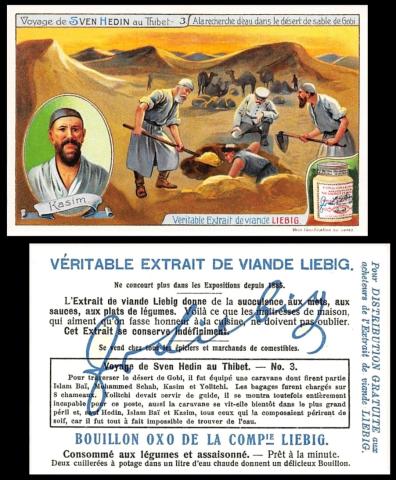
Liebig [trade : meat extract : O/S - South America) "Voyage de Sven Hedin au Tibet" (1908) F.0946 : S.0947
Not sure why I should pick this subject, I ought to have been writing of the cool breeze across the Arctic, to cool me down, but instead I found that it was #WorldSandDuneDay.
Now a sand dune is a natural phenomenon, and it is a very simple one. The sand is a light, loose collection of almost dust, and when the wind blows it moves the sand along the desert. Now if the wind stops after it has made a mound in one place, or the sand strikes a rock, the next time the wind blows it piles up behind that immovable object, until more and more sand is there. This makes the characteristic dune shape - the front, sheltered from the wind, being steeply sloped, and the back, where the sand is being blown, making a longer, gentler, slope as more and more sand is blown along its length.
I was surprised to discover that there are many types of sand dunes though - all depending on the wind and its direction. If the wind always whistles the same way, then you get ridges, long parallel lines following its direction, these are known as longitudinal dunes. However if the wind is scattered, and never blows the same way twice, the dune is rather higgledy piggledy, with inlets all over the place, and then it is known as a star, or sometimes a mound dune. There are also transverse dunes, which are like longitudinal dunes but going the other way across the desert.
On the other hand, dunes in areas of vegetation, especially by oases, are known as parabolic dunes, from their crescent-like shape, caused by them forming around the area where the wind is altered by the trees. This is shown quite well by card 47 of Ogden`s "The Story of Sand", issued in 1934, where it shows the sand piling up in a little crescent behind each plant. The text also tells us that "...plants tend not only to prevent the removal of sand by the wind, but also reduce the speed of the wind so that suspended sand is deposited, gradually raising the dunes. New roots are then sent out at a higher level, binding this loose surface sand." And the same set illustrates a small form of the longitudinal and transverse dunes on card 33, titled "wind patterns in sand".
That seems to be the only cigarette card set which shows the phenomenon. And the only other set to ours that I know of is another Liebig set, but a later one, issued in 1955, coded as F.1626 or S.1622, and called "Een Wanderling Door de Duinen" in Dutch or "Une Promenade dans les Dunes" in French - both of which translate to "A Walk through the Sand Dunes". This set is primarily interested in the flora, but still interesting to the subject we use today.
Our set was issued in at least two languages :
- French, as "Voyage de Sven Hedin au Thibet"
- Italian, as "Il Viaggio di Sven Hedin al Tibet"
As for Sven Anders Hedin, he was born in Sweden in February 1865, and his desire to become an explorer had started when he saw the rapturous reception of Adolf Erik Nordenskiold on his return from successfully navigating the Northern Sea Route for the first time.
His first overseas trip was to Persia, now Iran, in 1885, and two years later his first book was published, entitled "Through Persia, Mesopotamia and the Caucasus". The journeys shown on our cards come from the four expeditions he undertook to Central Asia between 1894 and 1908, during which many new geographical discoveries were made.
For a long time, his expeditions brought him much acclaim. However during the First World War he firmly, and irrefutably, allied himself with the Germans, and at the end of the war he seems to have been surprised that he was no longer to the public taste; his lecture tours were unpopular and scarcely attended, he lost memberships in several learned societies, and also many of his former backers were unwilling to support him for new trips.
And his views did not change during the Second World War, by which time he had moved to Stockholm.
Hedin died in Stockholm in 1952, leaving the rights to his books and his personal effects to the Royal Swedish Academy of Sciences. Many of these effects, souvenirs from his expeditions, were in his flat, piled high, and hardly visible.
He was buried at Adolf Fredrik Church in Stockholm, in the family grave.
By the way, you can find him on other cards. The earliest one I have found so far was issued in 1910 by American Tobacco Co., in the "Hassan" branded set "The World's Greatest Explorers". He is also card no.24 of F. & J. Smith's "Famous Explorers" (1911).
And card no.235 of "Die Grossen Weltgeschicte", which was issued by several manufacturers in Germany.
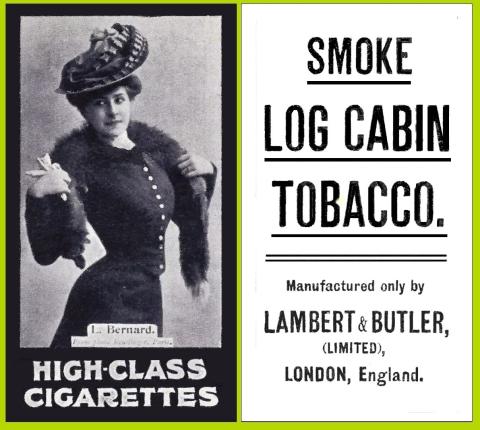
Lambert & Butler [tobacco : UK] "Actresses BLARM" (1900) Un/20 - L073-010 : L8-1 : L/9 [RB.9/9]
Today on #NationalLogCabinDay, let us celebrate the fact that early American settlers made the best of their surroundings, and used materials at hand to even build their homes.
Now there are plenty of log cabins on cards, but I have gone off on a tangent to show you this, a rather rare card indeed, branded for Log Cabin Tobacco.
This set is first described in our original reference book to Lambert & Butler, RB.9, issued in 1948. There are several sets entitled "Actresses", but it is easy to spot ours because they use the very same card as above to illustrate the set. The entry reads :
9. 20. ACTRESSES. (untitled). Size 2 11/16" x 1 7/16" or 68 x 37 m/m. Unnumbered. Fronts : Per Fig.2, printed by letterpress (Duotone) in black. Backs in black, inscribed "SMOKE LOG CABIN TOBACC). Manufactured only by LAMBERT & BUTLER, (LIMITED), LONDON, England". Two types of board : (a) thick (b) thin
- E. d`Alencon
- S. Arnoldson
- Avril
- L. Bernard
- Cleo de Berthyl
- Cassive
- La Cavalieri
- Chavita
- Darley
- Debriege
- Fishaut
- G. Gallois
- Lucy Gerard
- Manon
- Merode
- Mitzi-Dalti
- La Belle Otero
- V. Petit
- Selwich
- Yahne
In our updated World Tobacco Issues Index, this set is listed in section one, along with the other "Early issues without I.T.C. Clause. Issued 1898-1903 in home and export brands.". The description, however, is much reduced, and simply reads :
- ACTRESSES "BLARM" (A). Sm. 68 x 36. Black and white. Unnd. (20). See H.23 ...L8-1
The updated version of this book gives the same text as this, but a new card code, of L073-10
As for our lady, L. Bernard, I cannot track her down. We know, from the barely visible inscription in the box below her name, that this was a Reutlinger photo, and they were prolific photographers who supplied images for other cards, especially Ogden`s for the sets issued with Guinea Gold and Tabs brands. So if anyone sees this image on another card, with her Christian name, or with a biography on the reverse, please let us know.
I am also working on the theory that it may be E. Bernard, for Elsie Bernard, mainly because she was known for being able to contort her frame into a similar thinness that is being portrayed on this card. However she is mostly seen on postcards, and not cigarette cards.
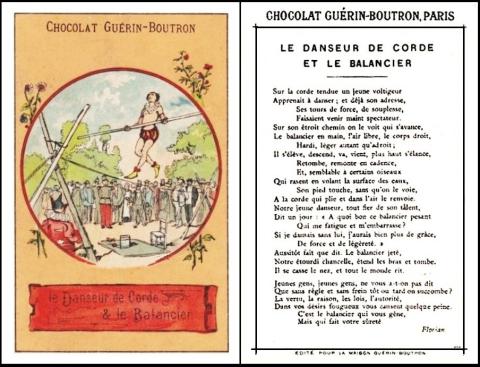
GUERIN Boutron [trade : chocolate : O/S - Paris, France] "Fables de Florian" (1902?) Un/??
This day held me up a bit, whilst I tried to find a card of the Rugby League player Don Hayward, born on this day in 1925. There is one, issued about 1995, by WPL Systems of Swansea, in a set called "Welsh Rugby Legends" - and that uses the same pictures as J. Ritchie`s "Welsh Wizards" - but I know nobody who has either set.
So back to square one, and, after a bit of a search, I discovered that today in 1859 saw Charles Blondin walk above Niagara Falls on a tightrope. Now there are few cards of Charles Blondin, almost all in sets we have used before. The easiest to acquire is definitely No.43 of Godfrey Phillips` "Famous Minors" (issued in 1936) - and the hardest is the unnumbered, backlisted Wm. Kimball set of "Champions of Games and Sports" (issued in 1887)
I will not attempt to tell you more than he was born Jean François Gravelet, on February the 28th, 1824, in Saint-Omer, France, and died at the age of seventy-two on February the 22nd, 1897, for there is a whole website devoted to him, and run by the Blondin Memorial Trust, which is far more learned than I could ever manage - and his biography is also written by a descendant of his.
Instead I have gone for a card that also was born in France, and issued by Guerin-Boutron. This is part of a set which uses tales and fables from the eighteenth century writer Jean-Pierre Claris de Florian, who was born in 1755 and died in 1794. Now his life story is often said to begin in poverty but that is not strictly true, for though his Spanish mother died when he was but a child he was taken in by his parental grandfather, who made sure he went to the best schools. Now this parental side of the family is very interesting because though I cannot track down his father`s name, the baby`s uncle, and guardian, was a Marquis, who made sure his young charge was seen by the right people, and even got him a placement as page to the grandson of Louis XIV. This set him up to go to a military college and to become a Captain in the Dragoons.
He was, however, not really an Army kind of guy, he was much more sensitive, kept to himself, and enjoyed writing poetry. So he left the Army and managed to get elected to L'Académie Francaise in 1788.
Unfortunately less than a year later the French Revolution broke out, and he was a bit of a target. He fled but was captured, and then imprisoned. He was held in jail for a long while, and whilst he was waiting to be put to death, he contracted tuberculosis, and died, in prison just a few months later, in September 1794.
His "Fables de Florian", from which these cards come, was printed in 1802. That is why I have plumped for 1902 as the date this set was issued, feeling, perhaps, that they were some sort of centenary celebration. I also know that there are seventy two cards, and that some of them are not only available with a different background colour (our gold, plus blue and pink), but some of the cards are in a different format, with numbers on them. Not sure how I will construct a list with that in mind, but I will have a think and come back.
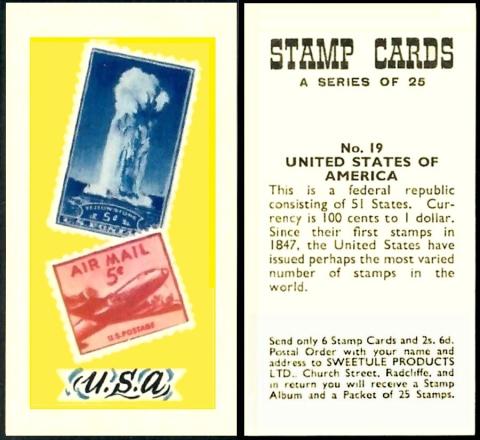
SWEETULE Products Ltd [trade : confectionery : UK - Manchester & London] "Stamp Cards" (1960) 19/25 - SWE-330 : SWA-17.1
Before I plough ahead, have you noticed that on the reverse, the text incorrectly tells us that "This is a Federal Republic, consisting of 51 States...". In fact there are but fifty states, still, plus the District of Columbia, which is a Federal District and not a State.
The reason for this stamp is that today is U.S. Postage Stamp Day - because today, July 1st, 1847, saw the first ever postage stamp. Before this time the recipient had to pay for the post when it arrived; but after this date the sender had to buy a stamp and stick it on before the mail would be delivered. The first two stamps depicted President George Washington and Benjamin Franklin, and each cost five cents, though the George Washington stamp allowed for longer distances or heavier mail. You can actually see them at the website of the National Postal Museum, which is part of the Smithsonian. They are black, or rather dark grey, similar to our Penny Black, which were first issued on May the 1st 1840, but, curiously, not valid for postage until the 6th May.
This set first appears in our British Trade Index part 2, as :
SWEETULE Products Ltd., Manchester & London.
Confectionery. Cards issued 1954-67.
- STAMP CARDS. Sm. ... SWA-17
1. Card Series. 68 x 37. Nd. (25)
2. Card with real stamp on reverse. 67 x 35. Unnd.
A bit more information appears in our updated British Trade Index, issued in the year 2000, where the entry reads :
SWEETULE Products Ltd., Manchester & London.
Confectionery. Issued 1954-67. Trial printings, in various colours of fronts and backs, are known for several sets. Address in listing (R) Radcliffe (W) Wood Green.
- STAMP CARDS. 1960-62. An album and 25 stamps was offered for return of 6 cards + 2/6d. Many different stamps affixed to cards.. ... SWE-330
1. Cards. 68 x 37. Nd. (25). (R).
2. Card with real stamp on back. 67 x 35. Unnd. (25) (R).
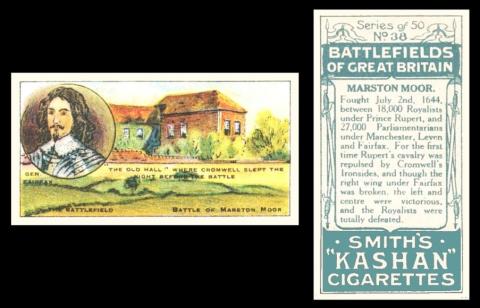
F. & J. SMITH [tobacco : UK - Glasgow] "Battlefields of Great Britain - `Kashan` brand (December 1913) 38/50 - S548-050.G : S84-2.G
Today we remember the Battle of Marston Moor, which was fought on this day in 1644. This was one of the skirmishes in the Wars of the Three Kingdoms, which are hardly remembered today - but involved the Scottish Covenanters, fighting for a Presbyterian Church of Scotland, against the wishes of the English monarchy. They teamed up with Oliver Cromwell`s forces, the Parliamentarians, or Roundheads, to fight the Royalists.
The Battle of Marston Moor was kind of the fall out from the siege of York, during which the Covenanters and Parliamentarians had been fighting the Marquess of Newcastle. On this day, both sides gathered their forces at a windswept meadow to the west of the City, and, towards the end of the afternoon, the Covenanters and Parliamentarians attacked. This was unexpected, and rather a melee; the fighting lasted for just two hours, and was really saved by Oliver Cromwell`s cavalry, which wreaked havoc amongst the opposing foot soldiers, four thousand of whom were killed and almost half that captured.
This really did change the course of the war, and the Royalists never ventured so far north again.
This is almost the final time we will regale you with one of these cards, for only one of the brands is left to feature on this website. The full details of the set, and a list of all the brands, can be found on its home page, with the Card of the Day for October 12, 2021 - and from there you can link out to all the other brands, where specifics of that brand and the subject on that particular card are displayed.
On the back of another set issued by F. & J. Smith, that being "Phil May Sketches", we are told a bit more about "Kashan" Turkish Cigarettes" namely that "By careful and expert blending we have been able to produce a Turkish Cigarette containing a delicacy of aroma and richness of taste which only choicest Eastern Tobaccos can give".
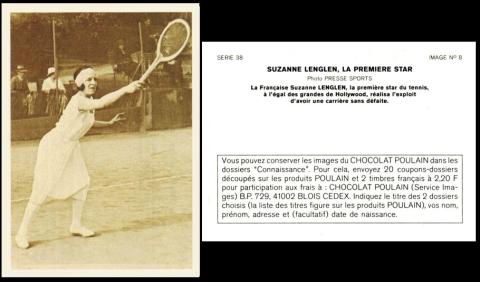
Chocolat POULAIN [trade : chocolate : O/S - France] "Sports" Serie 38 (19??)
Today, a centenary - of the Wimbledon Ladies Singles final in which Mlle. Suzanne Rachel Flore Lenglen beat Miss Joan Craddock Fry.
The match was rather a foregone conclusion, as Miss Fry was just nineteen years young, and Mlle Lenglen, aged twenty-five, had already won Wimbledon five times as a continuous run (1919-1923), though she was not the returning champion, having forfeited the 1924 final due to being taken ill.
Anyway this year she was in top form, and she beat Miss Fry 6-2, 6-0 in under half an hour.
However, I do not wish to malign Miss Joan Fry, who appears on four cigarette cards, at least. Her "Rookie" card is generally regarded to be card 18 of Churchman`s "Lawn Tennis" (1928), and they rate her pretty highly, by saying she was "Born May, 1906, is one of our best lady players of to-day. Won several singles in 1923 and 1924; won Birdhurst singles beating Miss McKane (Mrs. Godfree) in the final. Played for England v. Australia at Roehampton, and was a member of British team visiting Canada and Australia. Defeated Miss M.K. Browne in American Championships 1925, represented England in Paris at the French Championships where she defeated Miss E. Ryan. She beat Miss Betty Nuthall in the fifth round at Wimbledon 1927, reaching the semi-final. Miss Fry covers the court at a great pace, and retrieves balls which would beat the great majority of players".
She also appears on two more sets in the same year, Gallaher`s "Lawn Tennis Celebrities" (card 42) and Player`s "Tennis" (card 18). I thought that was her last card, but she does appear under her married name of Mrs. T. A. Lakeman, on Wills 1931 set of "Lawn Tennis" (card 15)
As for Mademoiselle Lenglen, she started playing tennis before she was a teenager, coached by her father, who was desperate to make her a champion and would go to any lengths to do so.
She won her first title, the World Hard Court Championship, in 1914, aged fifteen. However, this was just before the outbreak of the First World War, and all the major tournaments were cancelled. That meant her first Wimbledon was not for five years.
Once there, she caused rather a scandal, for, as you can see on our card, she did not cover her arms, shortened her skirt, and she refused to wear a corset. This allowed her much freer movement, and when her arms became brown from the sun she paved the way for ladies to sport a sun tan.
The end of her amateur career is rather a mystery. To all intents and purposes, she entered Wimbledon in 1926 as the defending champion, but was not at her best. She cites family troubles, a mixture of her father being in poor health, her own health not being completely up to par, and problems with finances. Then, at the last moment the organisers wanted her to change partners for the doubles, and take a French player instead of her usual partner and friend. She agreed, so long as this match would come before her singles and not after, but the two were suddenly swopped because Queen Mary, and some other Royals wanted to attend. Mlle Lenglen did contact the organisers and request they were returned to the order in which she had agreed but they claim not to have recieved her message. Therefore she arrived at the grounds late, and was chastised for keeping the Royals waiting. She then refused to play. And though the matches were then restored to the order in which she had agreed, she lost, and the newspapers blew it out of all proportion. On which she withdrew from the rest of the tournament, and turned professional, the first lady to do so.
The response of the All England Lawn Tennis Club to this, strangely, was to revoke her membership.
She never married, though she did have a long term companion, by the name of Baldwin Baldwin. He was very rich, and also married, and his wife refused to agree to a divorce. He claimed to be the son of Elias "Lucky" Baldwin, but he died in 1909, and I cannot find a son, though Mr. Baldwin senior had plenty of children and plenty of lovers too. Mlle. Lenglen met him during the tour which caused her expulsion from the All England Tennis Club, and they were soon inseparable. They stayed together until 1932, and I am wondering if perhaps he died?
Apart from playing tennis, she wrote several books, some factual instructions, and some more flippant. She appeared in a film, playing tennis ("Things are Looking Up" 1935), and she also got a job as a tennis coach in a school, which led to her opening her own tennis school, for girls, in 1936. When this was expanded to allow for adult lessons, she was offered a job as the director of the French National Tennis School in Paris.
Then, all of a sudden, she fell ill. It is not known with what, but it was serious, and she needed to have a blood transfusion. Some say that this was at fault, others not, but on the fourth of July 1938, three weeks after the transfusion had taken place, she died, aged just thirty-nine
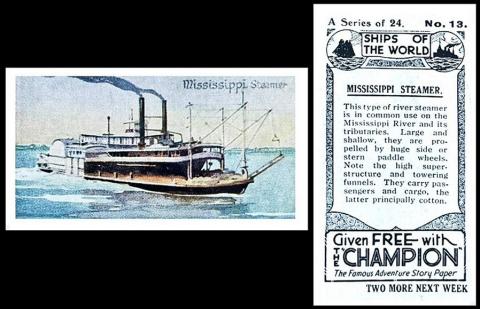
Amalgamated Press Ltd. [trade : periodicals : UK - London] "Ships of the World" (1924) 13/24 - AMC-14
And so to our final card, which is a bit of a tangent to today`s subject, of #NationalTomSawyerDay. However, throughout that book, the Mississippi riverboats pass by, plying their trade. So in lieu of any cards of Master Sawyer, this will have to set the scene.
The book was written by Samuel Langhorne Clemens, as "Mark Twain", and it was first published in 1876.
It is a strange book, and some of the set pieces are quite scary for children - worst of all, both this, and more so the follow up, "Adventures of Huckleberry Finn", are littered with racially offensive terms and epithets.
This set just deals with ships, and is much safer ground. It first appears in our original British Trade Index as :
- SHIPS OF THE WORLD. Sm. 68 x 36. Nd. (24). (C) ... AMC-14
This is a bit different in our updated British Trade Index, published in the year 2000, and it now reads :
- SHIPS OF THE WORLD. (C). 1924. 68 x 36. Nd. (24). Also issued in Australia, with "Two or more next week" on back, except one ... AMA-285
So does this mean our card above is the Australian version, or not?
I actually have a checklist of the set, which is :
- Solomon Islands Canoe (title in upper and lower case)
- CEYLON FISHING BOAT (this is the one without the "Two or more next week")
- NILE DAHABIEH
- IRRAWADDY TRADER
- CHINESE JUNK
- NEW GUINEA TRADER
- JAPANESE JUNK
- PORTUGUESE WINE-BOAT
- VENETIAN HEARSE BOAT
- SIBERIAN ICE BREAKER
- WHEAT WHALEBACK
- AMAZON STEAMER
- MISSISSIPPI STEAMER
- Danube Paddle Steamer (title in upper and lower case)
- OIL TANKER
- R.M.S. BERENGARIA
- DUTCH CANAL BARGE
- LIGHTSHIP
- DREDGER
- AUSTRIAN SCHOONER
I think that the reason that two cards are in upper and lower case is that capitals may not have fitted on the card.
As to why it is number two which has the missing inscription, I am not sure, unless they were issued out of order and this was the final card?
This week's Cards of the Day...
... celebrated the start of Windjammer Days, an annual event that takes place in and around Boothbay Harbour in Maine, USA, in order to keep alive the memories of when the sea was only crossable by tall sailing ships with stiff cloth sails and wooden masts.
These events started in 1962, on a very much smaller scale - it now lasts a week, and includes a plethora of seafood dining and a lighted boat parade.
Whilst it gives us a chance to look at some really unusual shipping related cards.... including what is thought to be the earliest shipping set ever circulated - unless you know otherwise?
Saturday, 21st June 2025
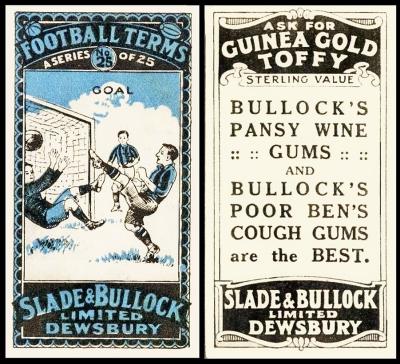
This clue was a real teaser, as one of the names for a windjammer is simply a tall ship - and the goalkeeper on any team is often the tallest player.
In fact, the tallest goalkeeper ever is Simon Bloch Jorgensen, a German, who played for Waltham Abbey in 2022, at the height of 6` 10.5".
Sadly there is very little information about this issuer or this set in our original British Trade Index, only an entry which reads:
SLADE & BULLOCK Ltd., Dewsbury
Confectionery. Cards issued about 1923-30
- CRICKET SERIES. Sm. 66 x 37. Brown portraits, blue surround. Nd. (25) ... SLA-1
- FOOTBALL TERMS. Sm. 66 x 37. Blue, black and white. Nd. (25) ... SLA-2
- MODERN INVENTIONS. Sm. 68 x 36. Nd. (25) Front (a) light and dark blue (b) yellow and purple ... SLA-3
- "NOW AND THEN" SERIES. Sm. 68 x 36. Blue, red and white. Nd. (20) ... SLA-4
- NURSERY RHYMES. Sm. 67 x 36. Pink, purple and white. Nd. (25) ... SLA-5
A. Back "Ask for Guinea Gold Toffy" with advertisements only
B. Back "Ask for Guinea Gold Toffy" with rhymes- SCIENCE AND SKILL SERIES. Sm. 67 x 36. Light and dark blue. Nd. (25) ... SLA-6
- SIMPLE TOYS & HOW TO MAKE THEM. Sm. 67 x 37. Orange, black and white. Nd. (25) ... SLA-7
- WORLD`S MOST BEAUTIFUL BUTTERFLIES. Sm. 62 x 37.Nd. (24) See D.2... SLA-8
And in the updated version it has changed little, only
SLADE & BULLOCK Ltd., Dewsbury
Confectionery. issued about 1924-27
- CRICKET SERIES. Sm. 66 x 37. Brown portraits, blue surround. Nd. (25) ... SLA-020
- FOOTBALL TERMS. Sm. 66 x 37. Blue, black & white. Nd. (25) ... SLA-030
- MODERN INVENTIONS. Sm. 68 x 36. Nd. (25) Front (a) light & dark blue (b) yellow & purple ... SLA-040
- "NOW AND THEN" SERIES. Sm. 68 x 36. Blue, red and white. Nd. (20) ... SLA-050
- NURSERY RHYMES. Sm. 67 x 36. Pink, purple and white. Nd. (25). Two backs ... SLA-060
A. Back "Ask for Guinea Gold Toffee" with advertisements only
B. Back "Ask for Guinea Gold Toffy" with rhymes- SCIENCE AND SKILL SERIES. Sm. 67 x 36. Light & dark blue. Nd. (25) ... SLA-070
- SIMPLE TOYS & HOW TO MAKE THEM. Sm. 67 x 37. Orange, black & white. Nd. (25) ... SLA-080
- WORLD`S MOST BEAUTIFUL BUTTERFLIES. Sm. 62 x 37.Nd. (24) See HX-23... SLA-090
However we have found out a bit more about the firm, which was eventually named after two men, but started with Ben Bullock, a coal miner from Burnley. He arrived in Dewsbury in the 1860s and by the 1880s he was making and selling sweets with a stall in the local market. He started simply, reputedly with aniseed balls, and sold his sweets for little more then they cost, but because of that they were affordable, so people bought more. He then expanded to the market in Heckmondwike in the days when sweets were a luxury for the working classes. Once he had the two markets, he found it harder to make enough sweets, so he rented premises, and then employed local people to make the sweets.
We also found out that he has a very big claim to confectionery fame, as he made the first ever stick of rock with letters through it. These were sold in Dewsbury market and somehow someone from Blackpool saw one and asked for some to be made specially. The first batch of "Blackpool" Rock were sent off in 1887. This led to other seafronts wanting the same and so he had to employ more people simply to make the rock, and, more importantly, specialists, to add the lettering, which was not easy to do.
In 1891, he changed the name to B. Bullock Ltd., and became a limited company. This brought him to the attention of Lever Bros, who we think of as simply selling soap, but at that time they sold many things and decided to add sweets to their stock, without wanting to employ people to make them. This added a lot more work, perhaps too much, and he retired in 1898. He may also have been swayed into retirement by receiving an offer from another confectioner, Slade`s, a fellow Yorkshireman, from Leeds. Not just that, but Mr. Slade wanted to uphold tradition, and rename the new firm as Slade and Bullock Ltd.
Sadly, this was not the success it may have been, as lots of sweet makers started coming along. Also, in 1918, the tax on "sugar and molasses made from beet grown outside Great Britain or Ireland" rose, and despite pleas from manufacturers was not reduced for some time. And so the firm closed in 1928. The one good thing is that Mr. Bullock never saw this sad end, as he moved to Southport in 1900, and died, not that long after, in 1905.
Sunday, 22nd June 2025
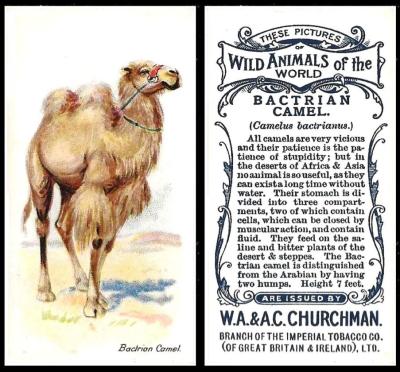
This card, of a camel, relates to one of the nicknames of that long suffering animal, "ship of the desert". There are many reasons as to why, but the best one, in my view, is that as they traverse the expanse, disappearing and reappearing behind the sand dunes, with their heads slightly bouncing, they do resemble a ship, bobbing along on the surface of the wave, rising the with the crest and falling out of sight as the movement of the waters takes them down.
I cannot believe that this is the first time that any version of the set has appeared on this website - but if it is, this will become the home page for all the issues. However for tonight we will only concentrate on the version at hand, by Churchman
This first appears in our original reference book RB.10, devoted to Churchman issues and published in 1948. In there, it is recorded as :
- 153. June 1907 50 WILD ANIMALS OF THE WORLD (titled series). Size 2 11/16" x 1 7/16" or 67 x 36 m/m. Unnumbered, no indication of number in series. Fronts lithographed in colour, on white background. Backs in blue, with descriptions. Printed by Mardon, Son & Hall.
Numbered below for convenience (titles from backs)
Also issued by Adkin, Franklyn Davey, Player, United Confectionery Co., and Wills.
Now I will type in that table (but not tonight) and then add the titles from both the fronts and the back to see how they differ.
In our original World Tobacco Issues Index, in which were collated all those books, and more, worldwide, cards besides, the entry is rather smaller, only :
- WILD ANIMALS OF THE WORLD. Sm. Unnd. (50). See RB.10/153 and H.77 ... C82-30
Monday, 23rd June 2025
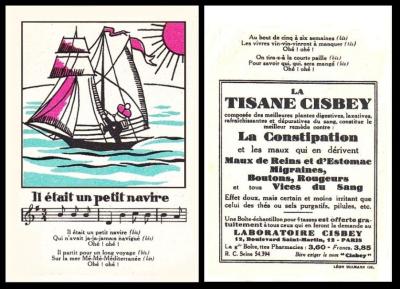
This card shows a tall ship, but more than that, it has a touch of gentle humour. And the name "Wind Jammer" has rather a joke, or perhaps more a jibe, about it, for it was the name given by more modern sailors to these majestic and stately, but also rather lumbering, ships, which took rather a long time to unload, and so they held up the traffic into the harbour, "jamming" them up.
It is clear from the typography that this set is late 1920s or early 1930s. It is definitely very different from the set of birds which we featured as our Card of the Day for the 21st of March, 2025 - though the relief of constipation is still at the forefront.
There is a rudimentary list, which, for the time being, is numbered, though the cards are not. That is only because it will be easier for me to see if we are nearing a round number and possibly a complete set. So those known so far are :
- Au clair de la lune
- Bon voyage Mr. Dumollet
- Cadet Rousselle
- Fanfan le Tulipe
- Il etait une bergere
- Il etait un petit navire
- Le bon roi Dagobert
- Le Mere Michel
- Malbrough s`en va t`en guerre
- Sur le pont d`Avignon
I was at nine, but then a reader added Mr. Dumollet - so perhaps we are looking at a set of twelve, missing two. If any one else can add any, please do.
Tuesday, 24th June 2025
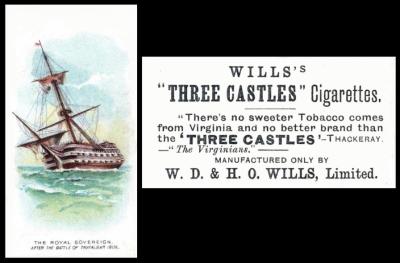
This ship is H.M.S. Royal Sovereign, the third ship by that name - and she would be succeeded by four more. She was a hundred gun, first rate, ship of the line belonging to the Royal Navy, launched out of Plymouth Dockyard on the 11th of September 1786. However she had been a long time building, as her order went in on the 3rd of February 1772 - so long that by the time she was launched she had been handled by three master shipwrights.
She first saw action at the first Battle of Ushant, in 1794, with the loss of fourteen men and the wounding of a further forty-one. Then she was sent to the French Revolutionary War, as the flagship of Vice-Admiral Cornwallis. A year later, she was in the news again, for she collided with a transport ship called the Bellisarius, which sank almost immediately.
Little is heard of her from then on, until 1805, when she becomes the flagship of Admiral Collilngwood at the Battle of Trafalgar. That meant that she led one column of ships into war, whilst Nelson, on the Victory, led the other. After a frantic, pitched battle, she had lost over a hundred and twenty of her men, and received several wounds to her body, her masts and rigging also being torn to pieces. In fact she could not continue to signal, nor even power herself and had to be towed home. Collingwood had to abandon ship and take over another vessel.
Despite this she was mended, and sent to patrol the Mediterranean, less than a year later. She served in France, and then along the English Channel, but then she was retired, back to Plymouth, where she was renamed to H.M.S. Captain, and finally broken up in 1841, though four of her guns were saved and incorporated in the Collingwood Monument, on Tyneside, where the bulk of her crews seem to have originated.
This set is first recorded in our original reference book RB.3 - "The Cigarette Card Issues of W.D. & H.O. Wills" - published in 1942. Even at that early date, enough was known about the set for the information to spread over several pages, and to cover four different versions thereof, so the entry starts with the following paragraphs, which aimed to enable the collector to sort out those versions :
SHIPS.
- A. Set One. 25 subjects only. FRONTS printed in full colour with titles in small letters. No framelines and without "Wills` Cigarettes" across card. BACKS printed in black with type letters only as follows "Wills` "Three Castles Cigarettes "There is no sweeter tobacco comes from Virginia" and no better brand than the "THREE CASTLES" - Thackeray - "The Virginians" - manufactured only by W.D. & H.O. WILLS, Limited.
- B. Set Two. 25 subjects only. FRONTS identical to Set One. BACKS printed in GREY with Star and Circle ornamental design. The card used for this set is quite different from Set Four, where the subjects are repeated. It can be described as white and glazed, and is heavier.
- C. Set Three. 50 subjects only. Entirely different studies from Sets One and Two. (Mr. Thornton Willis calls this set "Ships, Yachts and Strange Craft"). Fronts printed in full colour with titles in slightly larger letters than sets one and two. No framelines but with "Wills` Cigarettes" across card. Backs DARK GREY. When compared with Set Two these backs may be called "blue-ish grey" and Set Two "blackish-grey". The card is white, glazed, and heavier when compared with Set Four, where the subjects are repeated. Star and Circle ornamental design.
- D. Set Four. 100 subjects. Repeating the 25 studies from Set One, the 50 studies from Set Two, and 25 new studies added. Fronts FRONTS in full colour without frame lines. ALL CARDS IN THIS SERIES HAVE "WILLS`S CIGARETTES" ACROSS THE FRONTS. This means "Wills` Cigarettes" was added to the original studies for this issue. BACKS Star and Circle ornamental design. The printing has a greenish appearance, although the ink is probably blue. This is caused by a tinted card which has a faded appearance. On some cards this is very pronounced, on others it shows "buff", but in any case it cannot be confused with white.
(As there are many "mixed" sets in existence, this table should be studied closely before classification is attempted. Set Four is definitely on thinner board than any of the other sets.)
There then follows a list of the hundred cards and in which sets they appear - this will be scanned in asap.
Now before we get any further along, we must say that our use of the original code W/11 [RB.3/11] is actually partially incorrect, for in RB.3 none of the sets were given identifying numbers, they were simply listed in more or less alphabetical order, for the advertisement cards are listed first and then "Actresses" (1893), and, for some reason "Double Meaning" precedes "Coronation Series" - and these errors remained in place through the early Wills reference books, though with the addition of the codes they could easily have moved them into alphabetical order. Anyway, I digress. The code of W/11 only came in when the corrections and additions to those sets were printed at the front of RB.11 – The Cigarette Card Issues of W.D. & H.O. Wills Part I (revised) and Part II - published in 1948. In there, it says:
11. SHIPS - see pages 24-27.
The records of Wills mention the issue of these cards as follows:
- Ships (set of 25) Issue commenced 1895
- New Ships-Yachts, etc (50 designs) " " " " Aug.1896
The card listed as No.83 on page 26 bears the caption "H.M.S. Formidable. Launched 1898.
The four series can thus be summarised as follows :
- A. Series of 25. "Three Castles" backs. Issued 1895
- B. Series of 25. Grey backs. Issued 1895 ?
- C. Series of 50. Dark grey backs Issued 1896
- D. Series of 100. Greenish backs Issued 1898-9
As Series D is omitted in the record of Wills` issues referred to in the introduction to this volume, the series may prove to be an export issue; cards with the greenish back are often found in collections abroad, especially those made in India and the Far East.
25 cards of Series C are known without the red flags or pennons, i.e. red colour printing omitted.
Several printers` errors, in the list on pages 25-27, requite correction : -
- Card No. 1. H.M.S. Alexandra (not Alexandria)
- 39. R.M.S. Dunottar Castle (not Dunotta)
- 56. S.S. Tantallon Castle (not Tantallion)
- 88. Japanese Cruiser Idzumi (not Tozumi)
- 90. H.M.S. Immortalite (not Immortalitie)
- 91. Japanese Battleship Jakasago (not Cruiser)
- 92. Siamese Cruiser Maha Chakr Kri (not Chakri)
- 100. Japanese Cruiser Yoshino (not Joshino)
other small differences occur as between our listing and card titles, i.e.
- No. 18 First Class Torpedo Boat (not 1st Class), etc. etc.
Looking at the list I think that the Far East may well have been the area of issue, for out of the last twenty five cards five are Japanese and one Siamese. And it is not inconceivable that the set was designed to reinforce the power of the British Navy, at around the time that they were occupying of Weihaiwei (this began in July 1898) which was the main naval port in Northern China, and home to their best ships.
By the time of our original World Tobacco Issues Index, most of this information was not repeated, though both the original booklets were long out of print and only being made available, without covers, in a very limited way. Despite this, the entry reads :
SHIPS. (A). Sm. Unnd. See W/11 ... W62-45
- A. "Three Castles" back. (25)
- B. Scroll back in grey. Without "Wills`s Cigarettes" on front (25)
- C. Scroll back in blue-grey. With "Wills`s Cigarettes" on front (50)
- D. Scroll back, grey on brown board. (100)
This text remains the same in our updated version of the World Tobacco Issues Index, apart from a new code, of W675-064
Wednesday, 25th June 2025
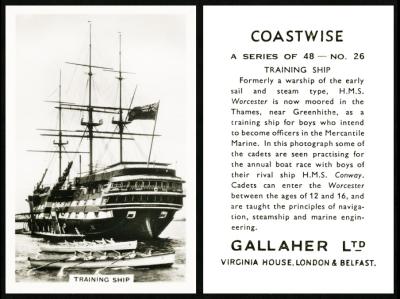
This ship, H.M.S. Worcester, is one of many ships by that name, eight in total, starting with a vessel launched in 1651. Amongst their ranks was a ship launched at the end of the First World War which also saw service in the second, and, at first, until I found out she was a destroyer, I thought she may be ours, but she was still in service when our card was issued.
Our ship turns out to have originally been called H.M.S. Frederick William, and she was launched in 1860. She was a training ship from 1876 until 1948 and run in tandem with the ex H.M.S. Exmouth for the last three years, until she assumed the name of H.M.S. Worcester instead and ours was used no more, being sold in July 1948, shortly after which she suffered some kind of difficulty and keeled over in the River Thames. She was raised in 1953, but was too badly damaged to restore and so she went to scrap.
Curiously, H.M.S. Frederick William was ordered in 1833 under another name, which was H.M.S. Royal Sovereign - the same as yesterday`s ship. Then there was a problem that saw the order cancelled, then restored but with a delay, and so today`s ship ended up being entered into the books for a second time, in 1839, but now as H.M.S. Royal Frederick. Building started in 1841, but took almost twenty years, on and off, and just before she was launched, in 1860, without actually being completely finished, it was as H.M.S. Frederick William.
Now we have already featured another version of this card, by Peter Jackson, but that was in our newsletter for the 22nd of March, 2025, as the diary card for Sunday 23 March. However a newsletter entry does not have the scope to become a home page for any group of sets and so some of that information has been relocated here, whilst that section only now pertains to the Peter Jackson version.
This version, by Gallaher, first appears in our original reference to cards of that issuer, which is RB.4, issued in 1944. It was actually only issued five years prior, and so I ought to be able to find an original New Issues Report, or two, by the time this newsletter is published. But in that booklet, the entry is quite a good one, reading :
- 1939. 48. COASTWISE. (titled series). Size 3" x 2" (approx.) Numbered 1-48. REAL PHOTOGRAPHS. Fronts toned black and white, glossy finish, white margins and titles inset. Backs, printed in black, with descriptions and "Gallaher Ltd., Virginia House, London & Belfast". (Similar to Pattrieouex). Produced by Lilywhite Ltd., Brighouse, Yorks.
By the time of our original World Tobacco Issues Index there has been a discovery, and the text now reads :
- COASTWISE. Md. Black and white photos. Nd. (48) See Ha.564-2 ... G12-79
This text is exactly the same in our updated World Tobacco Issues Index, but there is a new card code, of G075-570
As for the Ha.564.2 in the original volume, that leads us to the handbook which was published by the London Cigarette Card Company, and it tells us this set was not only issued by Pattrieouex, which we heard of in the original Gallaher reference book, but also others, namely :
GALLAHER GROUP. Four Photographic Series. Fronts glossy photographs in black and white. Four numbered series as follows :-
- 564.1 - Beautiful Scotland
- 564.2 - Coastwise
- 564.3 - Flying
- 564.4 - Our Countryside
Each series issued as follows :
- Gallaher - Medium Size, series of 48
- Illingworth - Medium Size, series of 48
- Peter Jackson -
A. Small size, series of 28
B. Medium Size, series of 48- Pattrieouex -
A. Small size, series of 28
B. Medium Size, series of 48, inscribed "SENIOR SERVICE CIGARETTES" without firm`s name. Captions in front in large or small letters
Thursday, 26th June 2025
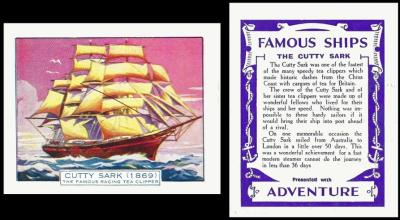
Our original British Trade Index part two lists this set as :
D.C. THOMSON & Co., Ltd., London
- FAMOUS SHIPS. Lg. 80 x 65, cut from pairs. Four series. Unnd. ... THO-10
1. Inscribed "Adventure" (8)
1. Adventure (1698)
2. Cutty Sark (1869)
3. Europa (1930)
4. Great Eastern (1853)
5. Lusitania (1915)
6. Santa Maria (1492)
7. Terra Nova (1910)
8. H.M.S. Vindictive (1918)
2. Inscribed "Rover" (8)
1. Erebus (1845)
2. Gjoe (1905)
3. H.M.S. Hood (1920)
4. Mauretania (1906)
5. Mayflower (1620)
6. Ranger (1778)
7. Royal George (1782)
8. Victory (1805)
3. Inscribed "Skipper"
1. Birkenhead (1852)
2. Blackbird (1870)
3. Britannic (1930)
4. Endurance (1914)
5. Golden Hind (1587)
6. Leif Ericsson (1926)
7. H.M.S. Queen Elizabeth (1914)
8. Resolution (1750)
4. Inscribed "Wizard"
1. Fram (1895)
2. Marie Celeste (1872)
3. Revenge (1591)
4. Satisfaction (1670)
5. Sirius (1838)
6. Sydney (1914)
7. Titanic (1912)
8. The World`s Biggest Liner
That last card names no ship. Instead it reads "The picture on this card shows what the world`s biggest liner will look like when she is completed. This mammoth vessel will be more than a thousand feet long, and inside her hollow masts are ladders wide enough for two persons to climb side by side. Her funnels are so big that the four steamers which formed the first Cunard fleet could be hidden inside them, and each of the four gear wheels in the engine-room will be heavier than an express railway engine. The speed of this ocean greyhound will be nearly 34 miles an hour. "
I promised that the final unidentified ship would be revealed in the newsletter, and it was to be the Queen Mary - she was built at Clydebank, starting in December 1930, but delayed, after this card had been circulated, at the end of December 1931, at which point Cunard had to ask the British Government for a loan. She was finally finished, and launched, on the 26th of September 1934.
Now the listing for this set is rather truncated in our updated British Trade Index, published in the year 2000, where the entry reads ;
D.C. THOMSON & Co., Ltd., London
- FAMOUS SHIPS. (AD)(R)(S)(W). 1931. 80 x 65, issued in pairs. Unnd. (32), in 4 series of 8. See HT-29 ... THO-225.
However HT-29, which leads you to the modern British Trade Handbook, lists all the cards, as above
Friday, 27th June 2025
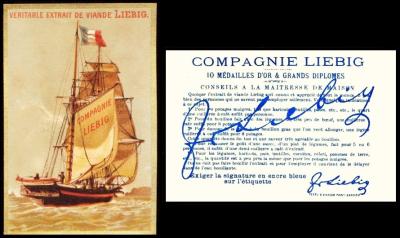
When I look at this card, I imagine how tough it must have been to import and export at the time this card was circulating. No aircraft either, you sailed or did not trade. And the distance from Uruguay to Europe was almost twelve thousand kilometres. At a good speed for 1833, of 31 km per hour, that`s 388 hours by my (admittedly terrible) maths - or sixteen days.
And I worry about bringing a can of tuna back from Chesham Waitrose....
Anyway, there is a whole load of confusion here, as there are two schools of thought about this set. Some people think it is a set of twelve, and others swear that it was intended to be two sets of six. And, adding even more complexity, the backs are also found in German, which leads to them being catalogued as follows :
- Les Navires à voiles - 1e edition - F.109 : S.109.a
- Les Navires à voiles - 2e edition - F.109 : S.109.b
- Les Navires à voiles - 1e German - F.109.a : S.110.a
- Les Navires à voiles - 2e German - F.109.a : S.110.b
The crucial thing here is that both the first and second edition are given the code of 109, by Fada and by Sanguinetti. So they were on the fence about it too. And it must be said that all twelve cards are decidedly similar from the front, gold borders, with the ship bravely battling on against a cloudy sky and choppy sea.
By the way, to add to the confusion, there is another set by a similar name, "Les Navires à voiles - a travers les ages", but that is coloured, and much later, being issued in 1927. The codes for that are F.1202 or S.1202.
And so, to steal a phrase from the "Looney Tunes" cartoons, "That`s All, Folks". It is late and well dark and I am resorting to the floating keyboard which appears on the screen, or it does when I remember how to get it to move there (which is seldom, and by accident).
If you are off hunting this weekend, have fun, and let`s hope you bag a bargain, or, failing that, that you get, at last, the one you never thought you would ever be able to slide, so carefully, in the gap between its friends.
It is worth paying a bit more to do that......
